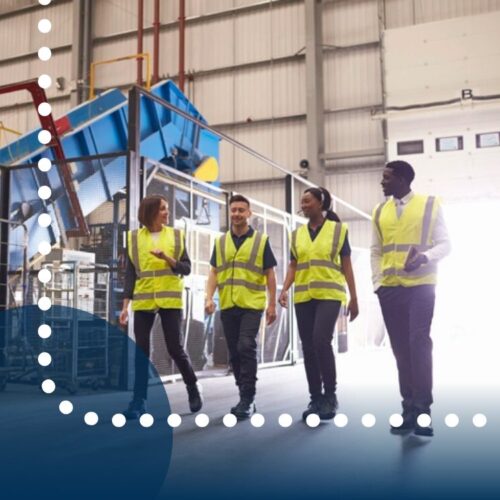
The month of June means different things to different people. It’s the end of the school year and the start of summer. Families line up for food and fun at outdoor festivals, or they host their own community get-togethers, picnics and barbecues.
June is also National Safety Month. When it comes to workforce well-being, your workers deserve to know they’re part of an organization that thinks ahead. National Safety Month is a chance for you to display that commitment while making strides for safety at your jobsite.
Where does National Safety Month come from, and how can your company participate? We’ve got the information you need.
The Movement for Safe Workplaces
As the U.S. economy transformed from its agricultural foundation to an industrially driven system, the shift to a safety-conscious workplace didn’t happen overnight. It emerged from hardship, resourcefulness and determination. Here are the key developments that shaped the previous century’s movement for safe workplaces:
- 1911 – The Triangle Shirtwaist Factory Fire Occurs
It would be very difficult to overstate the monumental significance of the fire at New York City’s Triangle shirtwaist factory. At the time, this was one of the largest industrial disasters in America, and most of its victims were young women from immigrant backgrounds. One of the most alarming features of this incident was that workers were locked inside the factory to discourage theft and unauthorized breaks. Since this led to many preventable deaths after the fire broke out, labor activists and organizations concerned with worker welfare responded strongly.
- 1913 – The National Safety Council (NSC) Is Established
A group of industry leaders came together and established the “National Council for Industrial Safety,” which was renamed the National Safety Council the next year to reflect a broader safety focus that extended beyond industry. In the era before substantial government regulation, the NSC was a private institution respected by the federal government for its leadership in keeping workers safe. They were called upon by President Franklin Delano Roosevelt in 1940 and granted a Congressional Charter in 1953.
- 1920s-1950s – Personal Protective Equipment (PPE) Is Introduced
In this era, substantial gains were made in the creation and integration of equipment that protected workers on the job. Personal protective equipment was first widely used in industrial environments following the deployment of respirators and gas masks on the battlefields of World War I. In the 1930s, the required use of visibility vests, steel-toed boots and hard hats started saving lives, including during the construction of the Golden Gate Bridge, while new harnesses helped prevent construction falls starting in the late ’50s.
- 1969 – The Board of Certified Safety Professionals (BCSP) Is Established
This organization sets impartial competency standards for safety professionals and provides an industry-leading credentialing service.
- 1970 – The Occupational Safety and Health Act Is Passed
With this legislation, federal legal codes were established to promote worker health and safety, and federal agencies were created to enforce such legal codes.
The video that’s displayed below was created by industrial supply company Grainger, and it does a great job of breaking down how the accident in 1911 affected the way organizations promoted safety in the following century. The video also explains how companies stand to benefit from cultivating cultures of safety.
Attitudes toward safety continue to evolve and grow. According to experts, organizations fare best when they strive to create a proactive safety culture and incorporate safety into their continuous improvement plans. This can lead to gains in productivity and quality as well.
National Safety Month Today
The NSC and related organizations are determined to make the Triangle fire the last time in which safety was prioritized only after the fact. Safety has to be a forward-looking priority, otherwise the risk is to spend too much effort into responding to tragedy instead of creating cultures of safety that prevent tragedies from ever occurring in the first place.
One way in which the NSC strives to keep safety at the forefront of everyday activity is by promoting events like National Safety Month. Every June, National Safety Month reminds us about the critical importance of safety, and the NSC offers resources to help workforce leaders discuss important topics with their teams.
Planning for Safe Futures
At Staff Management | SMX, we believe that we owe it to our associates to keep safety at the forefront of our thoughts. During National Safety Month, all of our associates are encouraged to participate in a contest that supports our company-wide safety efforts. We want to engage workers in a way that’s fun and creative. One year, associates were encouraged to submit dances that highlighted safety concerns. Another year, we asked our associates to unleash their inner wordsmith by submitting new safety slogans. This year, we want to find out which of our associates will come up with an astounding new safety logo.
Collaboration between our staff and associates is key to creating a proactive safety culture. These contests show our commitment to safety and demonstrate that we take the input of our associates on this topic very seriously.
National Safety Month Is a Time to Reflect
American workplaces have come very far over the last 100 years. Due to the diligent responses of companies, workers, governments and nonprofits, today’s workplaces are safer. One reason for the improvement in working conditions over the last century is that safety is not just a reaction to particular incidents or new regulations; for many companies, it’s a core cultural value. Events like National Safety Month encourage us to keep that value at the forefront of our practices and to integrate it into our workplace habits every day.
To learn more about how you can continuously improve the quality of your workplace safety initiative, refer to our ebook Best Practices for a Comprehensive Safety Program.



